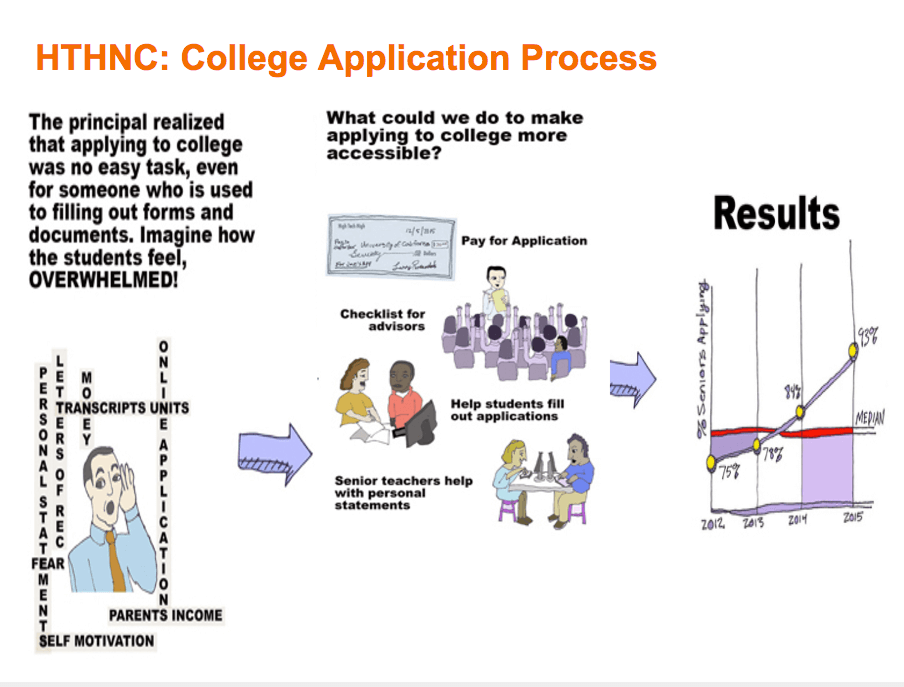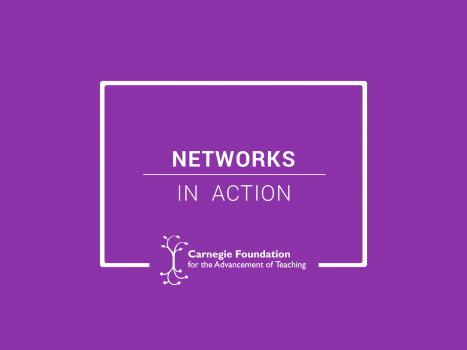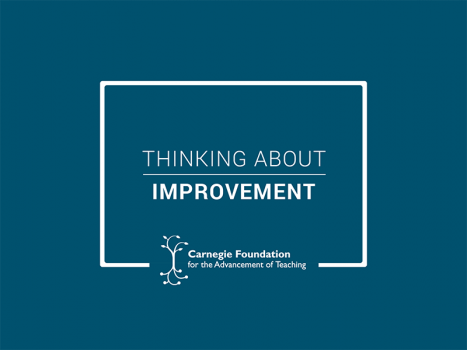Editor’s note: A core concept of improvement science is seeing the problem from the user’s perspective. High Tech High, a network of charter schools in San Diego County, has been bringing students directly into the change process through empathy interviews and other methods of understanding their students’ challenges. This summary of what teachers learned from using improvement science methodology is based on a recent article in Kappan magazine, written by High Tech High’s Kristen MacConnell and Stacey Caillier.
High Tech High, a charter management organization in Southern California with thirteen K-12 schools and its own graduate school of education, has been on an improvement journey to increase the number of students of color who go directly to 4-year colleges. It all began in 2014, when the director of one of their high schools, High Tech High North County (HTHNC), decided to apply to college himself and realized how challenging it was. Within two years, by focusing on support for the application process, HTHNC went from having the lowest percentage of students applying to and attending 4-year colleges in the organization to having the highest. During this same time, the HTH network of schools increased the total percentage of students going directly to 4-year colleges from 67% to 73%, and the number of boys of color going directly to 4-year colleges from 53% to 60%. Currently, about 45% of HTH faculty are engaged in sustained improvement work.
“What’s great is that we’ve gotten to a place as an organization where we have multiple schools where the whole faculty is engaged in improvement work together, and we have groups at different schools working on the same topics so there are opportunities to learn across sites” said Stacey Caillier, Director of the Center for Research on Equity and Innovation at High Tech High’s graduate school of education, during a phone conversation.
Caillier and Kristen MacConnell, an Educational Leadership resident at High Tech Elementary in Chula Vista (HTeCV)¹, write about the journey of a team at HTeCV in their recent Kappan article, “Getting better together: An elementary school uses improvement science to help students express and share their thinking.” When enacting changes to improve student learning, they note that educators “often struggle to set clear, measurable goals, let alone develop systematic ways for tracking our progress.” They go on to write that improvement science provides a clear methodology for developing and quickly testing ideas, as well as a “network structure that facilitates sharing and accelerated learning,” making it “a promising framework for scaffolding teacher learning and scaling good ideas.”

Created by Jeff Robin, art teacher at Gary and Jerri Ann Jacobs High Tech High School
Agency and Empathy
A fundamental aspect of improvement science is to give teachers agency to identify the specific problems that are creating roadblocks to achieve their goals for their school, their students, and their own professional development. “So many schools are trying to improve, but they’re being told what to improve by somebody else,” said Caillier. To ensure that teachers were invested in a problem that serves as the focus of their improvement efforts and its solutions, MacConnell and the Director of HTeCV asked teachers to consider three questions:
- What are my dreams for our school and for my students?
- How do I want to grow as an educator over the next year?
- If equity is at our core, what areas — in my practice and our school — are ripe for improvement?
The answers to these questions identified four issues the teachers felt would advance equity at the school that they wanted to address through improvement science. MacConnell led the team that focused on making thinking visible, inspired by the work of Harvard’s Project Zero. As one example, the authors describe the evolution of math talks in teacher Matt Sheelen’s first grade class. During the first math talk, when Sheelen asked for volunteers to share their answers to and ideas about a particular problem during class, such as a mathematics equation, only a couple hands went up. In later talks, Sheelen introduced a series of sentence starters that helped students not only articulate their own thinking, but respond to the thinking of peers by agreeing, critiquing, building on, and revising their previous responses. A few weeks later, students could not wait to share their thinking and Sheelen couldn’t call on all the hands that went up.
However, before any of these change ideas were introduced, Sheelen and his colleagues spent time trying to understand why students were reluctant to explain the thought processes they used to solve academic problems. Being able to articulate their thinking is an indication that the students not only know how to find an answer, but also have deeper knowledge of why one method for doing so is better than another, for example. The teachers reached out to students directly by conducting empathy interviews, asking what it was like to share their ideas in front of the class and what factors made it easier or more difficult to do. They learned that students didn’t like being rushed, wanted to share with a partner first, and were afraid of being judged negatively by classmates. During the empathy interviews, students also had an opportunity to suggest their own change ideas.
“One of our goals as an organization is to be as student-centered as we possibly can,” said Caillier. “We strive to be conscious about engaging students as collaborators; that’s what we aspire to.”
A Network Organized Around Improvement Science
Team members operated as a networked improvement community. They focused on a specific aim, were guided by a deep understanding of the problem and the system that produces it, were disciplined by the rigor of improvement science, and accelerated the learning into varied education contexts. They met every two weeks to discuss and analyze findings from the latest change idea they had tested, to explore existing research, and to plan their next steps. They constructed a fishbone diagram to identify the various reasons that students were hesitant to share their thinking and used that to develop action plans aimed at creating a safe environment that provided support for sharing and embedding opportunities for visible thinking into the daily routine.
Every change idea went through a round of inquiry, action, and reflection, known in improvement science as a Plan-Do-Study-Act (PDSA) cycle. The process doesn’t require long surveys, write the authors, “Capturing just enough data specific to a focused inquiry helped teachers get better at making student thinking visible. The teachers examined their data, reflected on their learning, and adapted their idea to improve practice.”
Kindergarten teacher Rosemarie Biocarles-Rydeen used video to gauge how well her students were adjusting to the making thinking visible exercise and found that her English language learners often said they needed more time. As a result, she started meeting with those students before starting that activity each day. Paul North inspired his third grade students to share their thinking by writing classroom blogs. North credited the network with energizing him to think of innovative activities. He told Caillier and MacConnell that “the social aspect of this experience has been empowering.”
High Tech High now has networks of educators across schools working to reduce chronic absenteeism, to improve literacy and mathematical agency, and to boost college access and persistence. Additionally, the Center for Research on Equity and Innovation at the High Tech High Graduate School of Education has started an improvement coach program, which is currently training 21 educators drawn from HTH and from the Knowles Foundation’s Project Ascent. Most of the HTH coaches are also supporting groups of teachers who are enrolled in High Tech High’s teacher credentialing program. CREI has developed a series of protocols and tools for guiding improvement work in schools. But if you want to get started now, MacConnell and Caillier share these tips for schools who want to use the networked improvement science approach:
- Make time for the work and be consistent about and protective of it
- Learn from your students through empathy interviews and by soliciting change ideas
- Focus your aim; make it specific enough so it leads to concrete action
- Dig into the literature by getting grounded in current research
- Focus on improving what you can control
- Start small by focusing on what you can do this week
One of the most interesting lessons for High Tech High came from answering this question: “Do you start with the people or do you start with the problem?” It would be simpler if the entire faculty agreed on a problem, but it often didn’t work that way, so some schools have teams working on different topics. “It’s been very important to us to start with the people and then let the problem surface up from them, so you’re not walking into a school saying, ‘We’re all working on literacy,’” Caillier explained. “It has to be something they’re super passionate about.”
-
HTeCV is a project-based charter school serving grades K-5. Admission is by zip code-based lottery to ensure enrollment reflects diversity of the community. Student Demographics: Asian 20%, African-American 7%, American Indian, 3%, Caucasian 8%, Hispanic 60%, Pacific Islander 2%, 55% free and reduced lunch, 20% English language learners, and 13% receive special education services.
November 29, 2016
The idea of forming collective action networks is growing among educators as they realize that today’s complex problems can’t be solved by one person alone. But there’s more than one type of community and which is best depends on the type of problem to be solved.
December 16, 2016
A new president, a new secretary of education, and a new version of ESSA are creating a confluence of unknowns about the future federal role in education policy. Carnegie Foundation scholars propose their recommendations as part of a series of Memos to the President.







